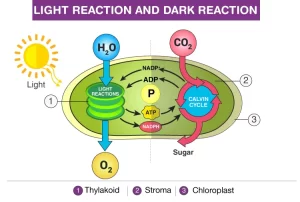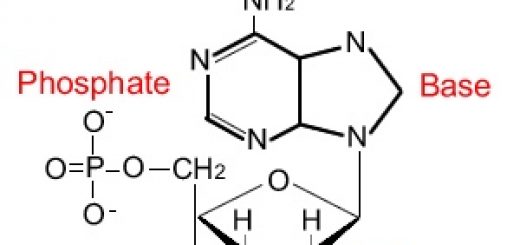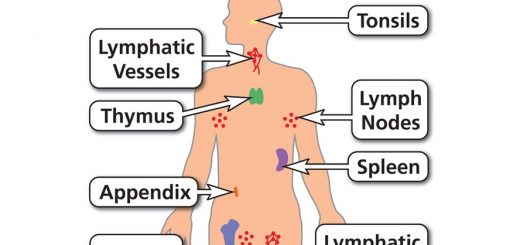Light and dark reactions of the photosynthesis process
In Blackman’s experiments on the limiting factors of photosynthesis, He concluded that photosynthesis consists of two kinds of reactions which are Light reactions (light acts as the limiting factor for the rate of photosynthesis), Dark reactions, or enzymatic reactions (temperature is the limiting factor for the rate of photosynthesis ).
Light reactions
Light reactions are a group of reactions that occur in the granum inside the green plastid, as it contains the chlorophyll pigments and the light is the limiting factor for the rate of photosynthesis.
Steps of light reactions
Light falls on the chlorophyll of grana inside the chloroplast, some electrons in the atoms of chlorophyll will gain energy, and these excited electrons are shifted up from their low-energy levels to the higher ones.
The kinetic light energy is stored as a potential chemical energy in the chlorophyll, so, the chlorophyll molecules are said to be excited or activated state.
When the stored potential chemical energy is released, the electrons fall once again to the lower energy levels and the chlorophyll will return to the stable state, ready for another influence of light to become excited once more.
Part of the energy released from the chlorophyll is used in splitting up the water molecule into hydrogen and oxygen, where: hydrogen combines with a co-enzyme present in the chloroplast ( NADP ) to give NADPH2, in this way hydrogen will not escape or recombine with oxygen again, Oxygen is released as a secondary product.
The other part of the energy from the excited chlorophyll is stored in the ATP molecule (energy currency in the cell ) by the combination of the ADP molecule ( which is present in the chloroplast) with a phosphate group (P) by means of a high-energy bond marked by a squiggle (∼), this process is called photosynthetic phosphorylation.
ADP + P → ATP
Adenosine − P ∼P + P → Adenosine − P∼P ∼ P
ADP: Adenosine DiPhosphate.
ATP: Adenosine TriPhosphate that carries the energy to the dark reactions.
NADP: Nicotinamide Adenine Dinucleotide Phosphate which acts as a hydrogen receptor.
Dark reactions
Dark reactions (Enzymatic reactions) are a group of reactions that occur in the stroma of chloroplast in which the temperature is the limiting factor for the rate of photosynthesis, so, these reactions can occur in both light and darkness.
In these reactions, hydrogen carried on NADPH2 is used to fix CO2 gas by reducing it into carbohydrates with the help of energy stored in ATP molecules.
Malvin Calvin and his associates at California University revealed in 1949, the nature of dark reactions by using the newly discovered radioactive isotope of carbon 14C.
Malvin Calvin experiment
steps:
- They placed the Chlorella alga in the apparatus.
- They supplied the alga with CO2 gas that containing the radioactive carbon 14C.
- The apparatus was exposed to a very brief light of a lamp to allow the photosynthesis process to take place.
- Chlorella was then immersed in a beaker containing hot alcohol to kill the protoplasm by stopping its biochemical reactions.
- They managed to separate the products of photosynthesis by special means and tested for the radioactive carbon in these compounds.
Results :
A 3-carbon compound was formed which is PGAL, phosphoglyceraldehyde, This is :
- The first stable compound is produced from photosynthesis.
- Used in building glucose, starch, proteins, and fats.
- Used in cellular respiration as a high-energy compound.
Calvin also pointed out that the synthesis of hexose sugar (glucose) is not completed in one step, but throughout several intermediate reactions catalyzed by certain specific enzymes.
Structure of leaf & green plastid, Mechanism of photosynthesis in green plants
Light wave properties, Analysis of white light, Spectrum colours & Light intensity
Types & Laws of light reflection, Regular & Irregular reflection of light
Light refraction effects, Law of light refraction, Mirage & Apparent positions of objects




